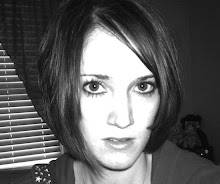I was looking through my resource notebook and found some things on color theory. Definitions...and a quiz. If you would like it, feel free to take.
Color Theory Vocabulary
1. Analogous colors: colors that are closely related; They are usually next to each other on the color wheel, as in blue and blue-green
2. Color: response of vision to the wavelength of light reflected from that surface
3. Color triad: a group of three colors spaced an equal distance apart on the color wheel
4. Complementary colors: two colors that are directly opposite each other on the color wheel
5. Cool colors: blues, greens, purples
6. Hue: another name for color; it is determined by the specific wavelength of the color in a ray of light.
7. Intensity: the saturation or strength of a color; a vivid color is of high intensity; a dull color is of low intensity
8. Local color: the naturalistic color of an object as seen by the eye (green grass, blue sky, red fire, etc.)
9. Monochromatic color: one color plus black and white
10. Neutralized color: color that has been grayed or reduced in intensity by adding neutral colors or a complementary color.
11. Neutrals: surface colors that do not reflect any single wavelength of light, but rather all of them at once. Neutral colors are white, black, brown, and gray.
12. Primary colors: the three colors that cannot be mixed or created. They create all other colors; Red, Yellow, Blue.
13. Secondary Colors: colors that are made by mixing two primary colors together: orange, green, and purple
14. Shades: a color plus black
15. Spectrum: the band of individual colors that result when a beam of light is broken into its different wavelength of colors.
16. Split-complement: a color and the two colors on either side of its complement
17. Subjective colors: colors chosen by the artist without regard to the natural appearance of the object portrayed. Subjective colors have nothing to do with the objective reality and they represent the expression of the individual artist.
18. Tertiary colors: a color made by mixing one primary color with one secondary color; blue-violet, blue-green, red-orange, red-violet, etc.
19. Tints: a color plus white
20. Warm colors: reds, oranges, yellows
21. Values: refers to the lightness or darkness of a color; it indicates the quantity of light reflected.
Color Theory Quiz
Name: __________________________________________________________
Directions: Please fill in the blanks below to answer each question.
- A landscape of hot temperatures or emotions might use a __________________ color scheme.
- Using two colors which are opposite each other on the color wheel is called a ______________________________ color scheme.
- Another word for color is _______________________.
- The lightness or darkness of a color is called _________________________.
- The compliment of red is __________________.
- The compliment of blue is ________________________.
- The compliment of yellow is _____________________________.
- Most earth tones are considered _____________________ colors.
- The peacefulness of a waterscape would very likely use a ________________ color scheme.
- The primary colors are _________________, ___________________, and __________________.
- The secondary colors are ______________________, ____________________, and ___________________________.
- Name three tertiary colors: ____________________, ___________________, _______________
- When you add white to a color, you create a __________ of that color.
- When you add black to a color, you create a ________________ of that color.
Enjoy :)


0 comments:
Post a Comment